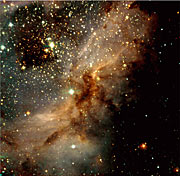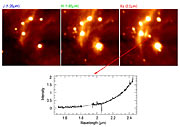Press Release
Peering into a Star Factory
SOFI Finds Young and Massive Stars in the Omega Nebula
14 September 2000
Beautiful images of astronomical objects often contain a lot of scientifically interesting information - PR Photo 24a/00, shown above, is a fine example of this old maxime. It provides a deep and unsually wide look into a giant star forming region in the Milky Way. It is known as Messier 17 (M 17), or the Omega, Swan, Horseshoe, or Lobster Nebula, because of its characteristic shape when photographed in visible light. It is located at a distance of approx. 5000 light-years (1.6 kpc), and is seen in the southern constellation of Sagittarius (The Archer), near the main plane of the Milky Way.
This impressive image was obtained by astronomers Leonardo Testi (Arcetri Astrophysical Observatory, Florence, Italy; p.t. Visiting Scientist at ESO-Chile) and Leonardo Vanzi (ESO-Chile) with the SOFI multi-mode instrument at the ESO 3.6-metre New Technology Telescope (NTT) at the La Silla observatory. The observations were made in the course of a research project that is aimed at the detection and study of the formation of massive stars, by means of near-infrared direct and spectral exposures with this instrument.
The new data offer a unique combination of a wide field-of-view, high sensitivity and excellent image quality. The goal of these particular observations was to identify massive stars that are in the act of formation in this area and to record their infrared spectra for a detailed physical study of these rather rare objects.
The formation of massive stars
It is now well established that the formation of stars in our galaxy, the Milky Way system, predominantly takes place in Giant Molecular Clouds. However, while low-mass stars are common and relatively easy to find in such clouds, it is much more difficult to find massive stars while they are in the very early stage of their evolution.
This is because massive stars are comparatively rare and pass through the different evolutionary phases much faster than low-mass and solar-like stars. They are usually found within dense stellar clusters, located at large distances from the Sun.
The earliest evolutionary stages of both low- and high-mass stars cannot be observed at visible wavelengths. This is due to the very heavy obscuration in that wavelength region by the dust in the parental molecular clouds. However, infrared and millimeter emission from these objects is able to penetrate the dust and thus allow us to investigate the complex processes that occur at the earliest phases of stellar evolution.
A search for massive stars in the formation stage
The best possible comprehension of this crucial stage of the stellar life cycle constitutes a key to the understanding of the formation and evolution of galaxies. And in this context, it is especially the massive stars with their powerful radiation fields, strong stellar winds and dramatic final interaction with the interstellar medium through supernova explosions that dominate the energetics of normal galaxies. Massive stars live much shorter (about 1 million years) than lighter solar-type stars (10 - 12,000 million years) and only they undergo such violent explosions at the end.
A most challenging question in current astrophysics is therefore concerned with the nature of the various physical processes that take place during the formation of massive stars. It is for instance still unclear whether massive stars form like lower-mass stars of the solar type do, i.e., by accretion of gas from the surrounding cloud during a progressive contraction process, or if they are rather the results of stellar collisions in dense clusters.
The only way to know is by finding the youngest massive stars and then to study them in detail by means of spectroscopic observations. At the same time, their immediate surroundings, e.g., the stellar population in the star-forming cluster of which they are members, must also be investigated before the full picture will emerge.
Massive stars in Messier 17
It is in this context that new infrared observations have been made of the inner regions of Messier 17. In the area to the south-west of the centre of this nebula, shown in ESO Press Photo eso0030a, several objects appear very red - this clearly identifies them as very young stars.
An infrared spectrum of one of the reddest objects that was only detected at the longest wavelength (the Ks band), confirmed it as a massive star in its earliest evolutionary phase.
The spectrum shows a featureless "continuum" that rises steeply towards long wavelengths, exactly as expected for a star in the process of formation, deeply embedded in dust. It is easily distinguishable from stars that have already formed, since their spectra display several absorption features and rise towards shorter wavelengths instead.
About the Release
| Release No.: | eso0030 |
| Legacy ID: | Photo 24a-b/00 |
| Name: | Horseshoe Nebula, Lobster Nebula, M 17, Messier 17, Omega Nebula, Spectrum, Swan Nebula |
| Type: | Milky Way : Nebula : Type : Star Formation |
| Facility: | ESO 3.6-metre telescope, New Technology Telescope |
| Instruments: | SOFI |
Our use of Cookies
We use cookies that are essential for accessing our websites and using our services. We also use cookies to analyse, measure and improve our websites’ performance, to enable content sharing via social media and to display media content hosted on third-party platforms.
ESO Cookies Policy
The European Organisation for Astronomical Research in the Southern Hemisphere (ESO) is the pre-eminent intergovernmental science and technology organisation in astronomy. It carries out an ambitious programme focused on the design, construction and operation of powerful ground-based observing facilities for astronomy.
This Cookies Policy is intended to provide clarity by outlining the cookies used on the ESO public websites, their functions, the options you have for controlling them, and the ways you can contact us for additional details.
What are cookies?
Cookies are small pieces of data stored on your device by websites you visit. They serve various purposes, such as remembering login credentials and preferences and enhance your browsing experience.
Categories of cookies we use
Essential cookies (always active): These cookies are strictly necessary for the proper functioning of our website. Without these cookies, the website cannot operate correctly, and certain services, such as logging in or accessing secure areas, may not be available; because they are essential for the website’s operation, they cannot be disabled.
Functional Cookies: These cookies enhance your browsing experience by enabling additional features and personalization, such as remembering your preferences and settings. While not strictly necessary for the website to function, they improve usability and convenience; these cookies are only placed if you provide your consent.
Analytics cookies: These cookies collect information about how visitors interact with our website, such as which pages are visited most often and how users navigate the site. This data helps us improve website performance, optimize content, and enhance the user experience; these cookies are only placed if you provide your consent. We use the following analytics cookies.
Matomo Cookies:
This website uses Matomo (formerly Piwik), an open source software which enables the statistical analysis of website visits. Matomo uses cookies (text files) which are saved on your computer and which allow us to analyze how you use our website. The website user information generated by the cookies will only be saved on the servers of our IT Department. We use this information to analyze www.eso.org visits and to prepare reports on website activities. These data will not be disclosed to third parties.
On behalf of ESO, Matomo will use this information for the purpose of evaluating your use of the website, compiling reports on website activity and providing other services relating to website activity and internet usage.
Matomo cookies settings:
Additional Third-party cookies on ESO websites: some of our pages display content from external providers, e.g. YouTube.
Such third-party services are outside of ESO control and may, at any time, change their terms of service, use of cookies, etc.
YouTube: Some videos on the ESO website are embedded from ESO’s official YouTube channel. We have enabled YouTube’s privacy-enhanced mode, meaning that no cookies are set unless the user actively clicks on the video to play it. Additionally, in this mode, YouTube does not store any personally identifiable cookie data for embedded video playbacks. For more details, please refer to YouTube’s embedding videos information page.
Cookies can also be classified based on the following elements.
Regarding the domain, there are:
- First-party cookies, set by the website you are currently visiting. They are stored by the same domain that you are browsing and are used to enhance your experience on that site;
- Third-party cookies, set by a domain other than the one you are currently visiting.
As for their duration, cookies can be:
- Browser-session cookies, which are deleted when the user closes the browser;
- Stored cookies, which stay on the user's device for a predetermined period of time.
How to manage cookies
Cookie settings: You can modify your cookie choices for the ESO webpages at any time by clicking on the link Cookie settings at the bottom of any page.
In your browser: If you wish to delete cookies or instruct your browser to delete or block cookies by default, please visit the help pages of your browser:
Please be aware that if you delete or decline cookies, certain functionalities of our website may be not be available and your browsing experience may be affected.
You can set most browsers to prevent any cookies being placed on your device, but you may then have to manually adjust some preferences every time you visit a site/page. And some services and functionalities may not work properly at all (e.g. profile logging-in, shop check out).
Updates to the ESO Cookies Policy
The ESO Cookies Policy may be subject to future updates, which will be made available on this page.
Additional information
For any queries related to cookies, please contact: pdprATesoDOTorg.
As ESO public webpages are managed by our Department of Communication, your questions will be dealt with the support of the said Department.


